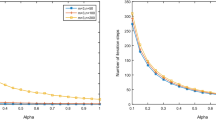Abstract
In this paper, we are concerned with finding the least solution to the tensor complementarity problem. When the involved tensor is strongly monotone, we present a way to estimate the nonzero elements of the solution in a successive manner. The procedure for identifying the nonzero elements of the solution gives rise to an iterative method of solving the tensor complementarity problem. In each iteration, we obtain an iterate by solving a lower-dimensional tensor equation. After finitely many iterations, the method terminates with a solution to the problem. Moreover, the sequence generated by the method is monotonically convergent to the least solution to the problem. We then extend this idea for general case and propose a sequential mathematical programming method for finding the least solution to the problem. Since the least solution to the tensor complementarity problem is the sparsest solution to the problem, the method can be regarded as an extension of a recent result by Luo et al. (Optim Lett 11:471–482, 2017). Our limited numerical results show that the method can be used to solve the tensor complementarity problem efficiently.
Similar content being viewed by others
References
Huang, Z., Qi, L.: Formulating an \(n\)-person noncooperative game as a tensor complementarity problem. Comput. Optim. Appl. 66, 557–576 (2016)
Luo, Z.Y., Qi, L., Xiu, N.H.: The sparse solutions to \(Z\)-tensor complementarity problems. Optim. Lett. 11, 471–482 (2017)
Song, Y., Yu, G.H.: Properties of solution set of tensor complementarity problem. J. Optim. Theory Appl. 170, 85–96 (2016)
Bai, X.L., Huang, Z.H., Wang, Y.: Global uniqueness and solvability for tensor complementarity problems. J. Optim. Theory Appl. 170, 72–84 (2016)
Song, Y., Qi, L.: Error bound of \(P\)-tensor nonlinear complementarity problem. arXiv preprint arXiv:1508.02005v2 (2015)
Che, M., Qi, L., Wei, Y.: Positive definite tensors to nonlinear complementarity problems. J. Optim. Theory Appl. 168, 475–487 (2016)
Ding, W., Luo, Z., Qi, L.: \(P\)-tensors, \(P_0\)-tensors, and tensor complementarity problem. arXiv preprint arXiv:1507.06371 (2015)
Huang, Z., Suo, Y., Wang, J.: On \(Q\)-tensors. arXiv preprint arXiv:1509.03088 (2015)
Song, Y., Qi, L.: Properties of some classes of structured tensors. J. Optim. Theory Appl. 165, 854–873 (2015)
Gowda, M.S., Luo, Z., Qi, L., Xiu, N.: \(Z\)-tensors and complementarity problems. arXiv preprint arXiv:1510.07933 (2015)
Song, Y., Qi, L.: Properties of tensor complementarity problem and some classes of structured tensors. arXiv preprint arXiv:1412.0113v2 (2014)
Wang, Y., Huang, Z.H., Bai, X.L.: Exceptionally regular tensors and tensor complementarity problems. Optim. Methods Softw. 31, 815–828 (2016)
Li, X., Voroninski, V.: Sparse signal recovery from quadratic measurements via convex programming. SIAM J. Math. Anal. 45, 3019–3033 (2013)
Lauer, F., Ohlsson, H.: Finding sparse solutions of systems of polynomial equations via group-sparsity optimization. J. Global Optim. 62, 319–349 (2015)
Ding, W., Wei, Y.: Solving multi-linear systems with \({\cal{M}}\)-tensors. J. Sci. Comput. 68, 689–715 (2016)
Xie, Z.-J., Jin, X.-Q., Wei, Y.: Tensor methods for solving symmetric \({\cal{M}}\)-tensor systems. J. Sci. Comput. doi:10.1007/s10915-017-0444-5 (2017).
Li, D.-H., Xie, S.-L., Xu, H.-R.: Splitting methods for tensor equations. Numer. Linear Algebr. doi:10.1002/nla.2102 (2017)
Qi, L.: Eigenvalues of a real supersymmetric tensor. J. Symb. Comput. 40, 1302–1324 (2005)
Ding, W., Qi, L., Wei, Y.: \({\cal{M}}\)-tensors and nonsingular \({\cal{M}}\)-tensors. Linear Algebra Appl. 439, 3264–3278 (2013)
Zhang, L., Qi, L., Zhou, G.: \(M\)-tensors and some applications. SIAM J. Matrix Anal. Appl. 35, 437–452 (2014)
Kannan, M.R., Snaked-Monderer, N., Berman, A.: Some properties of strong H-tensors and general H-tensors. Linear Algebra Appl. 476, 42–55 (2015)
Cottle, R.W., Pang, J.S., Stone, R.E.: The Linear Complementarity Problem. SIAM, Philadelphia (2009)
Acknowledgements
The authors would like to thank the editors and anonymous referees for their valuable suggestions which helped us to improve the paper. This paper was supported by the Chinese NSF Grants 11371154 and 11601188, by the Training Program for Outstanding Young Teachers in Guangdong Province (Grant No. 20140202), and by Educational Commission of Guangdong Province, China (Grant No. 2014KQNCX210).
Author information
Authors and Affiliations
Corresponding author
Additional information
Communicated by Guoyin Li.
Rights and permissions
About this article
Cite this article
Xie, SL., Li, DH. & Xu, HR. An Iterative Method for Finding the Least Solution to the Tensor Complementarity Problem. J Optim Theory Appl 175, 119–136 (2017). https://doi.org/10.1007/s10957-017-1157-5
Received:
Accepted:
Published:
Issue Date:
DOI: https://doi.org/10.1007/s10957-017-1157-5




